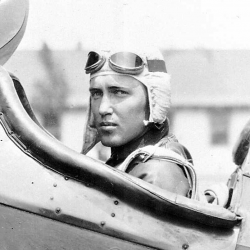
 |
|
|
||
|
Robert Moffat Losey |
||||
|
Graduate, U.S. Military Academy, Class of 1929 Engagements: • World War II (1941 - 1945) |
||||
| Biography: | ||||
|
Robert Moffat Losey Robert Moffat Losey was born on 27 May 1908 in Andrew, IA, to Presbyterian clergyman Leon A. Losey and his wife, Nellie Moore Losey. He graduated from Trenton High School in Trenton, NJ in 1924. He was appointed to the U.S. Military Academy in 1925. After graduating among the first 100 members of the Class of 1929, he was commissioned as a Second Lieutenant of Field Artillery, but transferred one year later to the Air Corps. He received his wings from the Air Corps' Advanced Flying School in San Antonio, TX, on 11 October 1930. Losey then earned two Master's degrees from the California Institute of Technology, while serving as a Meteorologist in California. Professors described him as 'perhaps the most brilliant student' who ever attended the school. On 10 April 1933, he was married to Kathryn Leona Gault "Kay" Banta of California. Washington, DC From August 1937 to January 1940, Losey was on duty in Washington with the office of Training and Operations Section of the Office of the Chief of the Air Corps, Major General Henry H. Arnold. There, he served as the first Chief of the Weather Section, and was considered "the Army's crack aeronautical meteorological expert." Nordic Countries In February 1940, Losey began serving as the Air Assistant to the Military Attaché with the U.S. Embassy in Finland. News accounts indicated his mission was to report on air developments in the Russo-Finnish War (where the harsh winter conditions provided a special opportunity to observe the interplay between meteorology and military aeronautics). As the German armed forces began their Norwegian Campaign, Losey was directed first to Sweden, then to Norway. After arriving in Norway he immediately became involved in efforts to evacuate the American Legation to safety across the Swedish border. The American Legation was divided into two parties. The first party, including Losey and Ambassador Florence Jaffray Harriman, reached Sweden safely, but had lost contact with the second party. Losey volunteered to return to Norway in search of the remainder of the Legation. According to Ambassador Harriman, Losey dissuaded her from accompanying him and Harriman's chauffeur on the rescue effort, and warned her that "you might be bombed," and "the Germans are strafing the roads." As Harriman later recounted in her book, Mission to the North, Losey told her that "I certainly don't want to be killed, but your death would be the more serious as it might involve our country in all kinds of trouble, whereas with a military attaché . . . ." Harriman stayed in Sweden. Seeking out the Americans, Losey and the chauffeur passed through Dombås, a strategic railway intersection, just as a German Luftwaffe bombing began. The two sought refuge in a railway tunnel with others, but once in the tunnel Losey stood where he could observe the bombing. After a bomb fell near the entrance to the tunnel, a fragment of it pierced Losey's heart, killing him. Several days later, Luftwaffe Commander Hermann Göring sent to Major General Arnold a message of regret regarding Losey's death. After the U.S. entered the war, Hollywood filmmaker Frank Capra included a brief account of Losey's death in "Divide and Conquer," the third episode of his propaganda film series, "Why We Fight," which he produced on behalf of the U.S. Army Signal Corps. Honors The citizens of Dombås erected a monument in Losey's honor in 1987. In 1940, the American Institute of Aeronautics and Astronautics established the Robert M. Losey Award in his memory. That honor, known since 1975 as the Losey Atmospheric Sciences Award, is presented in recognition of outstanding contributions to the atmospheric sciences as applied to the advancement of aeronautics and astronautics. In 1941, the Army Air Corps established Losey Army Airfield east of Ponce, Puerto Rico, near the Island's southern coast. Losey Field became known as Camp Losey when it was turned over to the Army's ground forces in 1944, and Fort Allen when it was turned over to the Army's Caribbean Signal Agency in 1959. Death and Burial Captain Robert Moffat Losey died on 21 April 1940 in Dombås, Norway. Losey's remains are buried next to those of his mother at the U.S. Military Academy Post Cemetery in West Point, NY. |
||||
| Honoree ID: 2782 | Created by: MHOH | |||
Ribbons
Medals
Badges
Honoree Photos
 |  |  |
 |  |
 |


